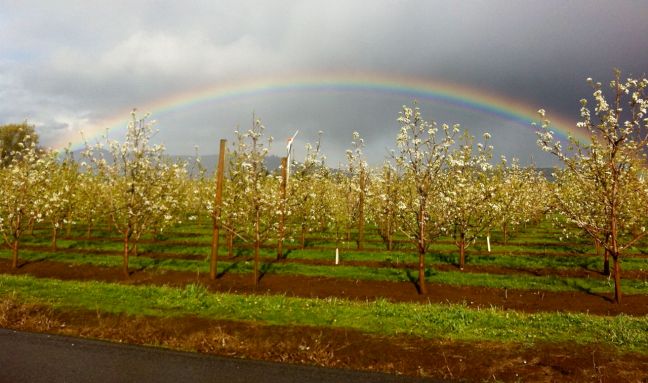
Silver lining on a bleak early spring day.
Love press of the kitchen and furniture
beautifully grown tree
past month is.
Okay, from the poem above, you probably think this is going to be about how I’ve finished my cabinetry and built-ins, perhaps my whole house. Given that it’s been four months since my last post, this would be a reasonable assumption, but alas, this is not the case. In fact, I am amazed at how slow my progress has been as I approach my two-year mark from when I started building. In my defense, the first year I was living in one state and building in another when I could get time off work, and this last year has been beset by obstacles. However, it hasn’t been wasted time. Much has been learned and I am very happy with what has been accomplished. Though more battle-worn and less starry-eyed, I’m still as excited as ever about my tiny house. Good thing, eh?
In honor of this anniversary, this post is a look back on some of what I’ve learned these last few months about patience, potential, and perseverance. There are also some observations about nature, design, aging, as well as a look at some of the actual work – my electrical wiring, sealing the windows gaps, and starting to fluff wool for insulation – that I did manage to do. But first, because I’m never content with mere reporting of my building steps, I want to explain the origins of the poem above and the others included in this post:
Exquisite corpses & found poems
You’ve probably played the parlor game favored by the Surrealists called Exquisite Corpse, where one person begins a drawing on a folded piece of paper and passes it to the next person who adds to it not knowing what the first person drew. This continues until the last person adds their contribution and the paper is unfolded to see what this blind, collaborative creative process produced, quite often something nonsensical or, ahem, surreal.
The idea can be applied to other art forms as well. In film school, we would pass a camera around not knowing what the previous filmmakers had filmed, resulting in typically disjointed, but interesting, short films highlighting our very different cinematic styles. Written stories or poems can also be developed this way. It’s somewhat similar to the found poetry that grew out of the Dadaist movement. Like with the exquisite corpses, the appeal of found poetry, or found art, is the fresh insights or unexpected synchronicities that occur when artists portray commonplace objects or text in a new light.
In my case, my exquisite corpse/found poetry turned out to be an inadvertent collaboration between KitoBito, a small Japanese woodworking company specializing in kitchen designs; Google translator; and myself. As I was recuperating and unable to build (see below), I spent time researching my cabinet design. Through a random search, I ended up on KitoBito’s site and fell in love with their work. But beyond giving me inspiration for my own designs, I made a delightful discovery when I saw what random beauty and thoughtful word play was being generated by the Google translator!
Reading between the lines, I can gather that the content writer for the KitoBito website was discussing the benefits of beautiful, custom-made wood furniture and cabinetry. I’m sure it was quite lyrical and descriptive to start with, but what came through the translator was at times quite mangled, inexplicable, and often funny:
While enjoying a serious loitering, various colors of kitchen and furniture skeleton will be completed… Life even if also painful, satisfaction at the top of the feeling of in such a thing, I was also confident that it would become manure is for sure the future of their own… Pull for me tightening crisp facial expressions is basically uses the iron. Is impregnated only a little like the worn-out handkerchief of oil, please let them soak in as skin care. It becomes rust. You can also change the brass by hope also so hard to throw brass.
But then, occasionally, the rather dubious translations came out mind-blowingly poetic. I copied some of the best of these down and played with arranging them in a more intentional format, with minor punctuation tweaks. These are what you see throughout the post in italics. I am no poet, and make no pretense of knowing much about poetry, but I do know what speaks to me, and these did. I love the magic that comes through these random happenstances, across language and cultures, filtered through the mock consciousness of a robot, into some semblance of wisdom. I hope you will enjoy them as much as I do.
My growing connection to trees
Location to advance the hand.
From the window, you will see
a view of the narrow
while full of green garden.
Hard we are working, and then relieved
when the trees can be seen
when suddenly glanced
outside.
This was taken from a description of KitoBito’s workshop, built from trees on owner Masayuki’s father’s nearby property. Like the others, it’s been run through the vagaries of the Google translator, but I love how it captures a sense of rightness of place and the intertwined nature of the woodworker and the environment!
I’m realizing just how connected I am to trees. I thought my heart would break walking around our freeze-injured patients, wondering if they would pull through. Maybe they are a totem for me as I try to find some kind of balance between my tendency to wander and my conflicting desire to put down roots. But they also represent growth and patience. They provide shade, food and homes to creatures when alive, and warmth and raw materials when they’re not. They are simply beautiful.
Last fall I took several woodworking classes and further grew to appreciate trees and wood. I wanted to learn to use both power and hand tools in preparation for building my cabinets, but also because I knew in my heart I wanted to work with wood, to spend the next phase of my life learning the art of it.
I’m mentioning all this as background for some of what I’ve been dealing with lately.
Challenges of the last few months
Thinking back to exquisite corpses, let’s talk about this aging business! It’s probably just because I finally had time to go see the doctor about various things I had been putting off, but it seemed like I turned 50 and suddenly everything decides to fall apart.
A bump I had on the inner part below my lower eyelid turned out to be a basal cell skin cancer. Fortunately it’s not particularly serious but because of it’s nearness to my eye, I had to go to one surgeon to have it removed and then to a reconstructive plastic surgeon to have it repaired. 24 stitches later, I was banned from building for a month. Blech.

The plastic surgeon ended up cutting up from the wound site, all along beneath my lashes and out about a half inch from the outer corner of my eye to peel the skin back and stretch it to cover the wound. And I was awake for it all! This was taken after I took off the bandage I had to wear over my eye for a week (hated that).
On top of this, I’ve had trouble swallowing, particularly last fall and winter. After an endoscopy, biopsies, and dilation of my esophagus, turns out I have an autoimmune disease called eosinophilic esophagitis, where my white blood cells are attacking my esophagus. Left untreated, it could completely close off my esophagus and I’d have to be fed through a tube in my stomach, but fear not, I think we’ve got it under control. No one is quite sure what the root cause is, but major contributing factors are food and environmental allergies, and stress. The last few months have been a frustrating roller coaster of tests and trying to figure out what I can and can’t eat – it was driving me nuts (which turns out I’m allergic to – who knew?). Turns out food allergies pale in comparison to the thing I’m most allergic to: tree pollen and (wait for it…)
SAWDUST!!!!
This explains my exhaustion last fall, when I had been working with cedar siding, one of the worst tree species for allergies, and also when I was taking my woodworking classes, all without wearing any kind of mask. Now that we have it fairly figured out, my life has gotten mostly back to normal. I take some medications and have to wear a respirator any time I work on the house, even if I’m not sawing anything. It makes me move even slower since there’s not a good flow of oxygen through the mask but I’m hoping it’s similar to training at high altitudes for the Olympics. Fortunately there should be a marked improvement once we’re through pollen season and the house is done (no pressure, patience, breathe, breathe…).
The bummer is what this means for my future plans in woodworking, but hopefully I can work around this little inconvenience. This has all been a little surreal since I’ve always been more or less healthy and really don’t feel like I’m 50 most of the time. It would be easy to get depressed, but I’m also learning you can choose to lean into it and look for those silver linings. As I go into below, the tiny house and the natural world have come through with some good life lessons in all of this.
The color of the wood will come tinged with depth
to each overlapping month
to say aging.
Increases the taste of it,
beauty when the month has passed.
The color of the wood increases the depth in aging.
Scratch I become taste,
taste comes out to scratch.
Patience:
- Quietly and steadily persevering or diligent, especially in detail or exactness.
- Bearing provocation, annoyance, misfortune, delay, hardship, pain, etc., with fortitude and calm and without complaint, anger, or the like.
I’m pretty good at the first one, less good at the second, particularly the bearing with fortitude and calm bit. My personal paradox is knowing that my greatest potential is achieved by being slow and methodical, but at the same time I’m incredibly impatient to get to where I’m going. My mind is always in the future, planning, dreaming, designing. Ever since I became interested in tiny houses, the one part I’ve been most eager to complete is to get the interior walls up. Partly this is because it is such a sure sign of progress toward making the house feel real, and partly I’ve longed for it because, though I know it will have its own set of challenges, it feels like it will be fairly easy and a relief from the brain-bending and skill-challenging aspects I’ve been dealing with up until now. I so want those walls up! I’m so close and yet it feels so far. There seem to be interminable amounts of prep and details to work through just to get to the walls. And that makes me impatient.
Well, sometimes the universe has to knock you upside the head to make you wake up. I’ve had a lot of time to dwell on patience and potential due to the host of health issues I’ve had to contend with. While this has been extremely frustrating, it could be much worse, and there are those silver linings if you look hard enough. Like the reminder that the best things in life take their own sweet time.
Gardening, for example. You can’t really hurry growth, and if you try, it will probably backfire. I had been string-trimming the blueberry beds and making raised vegetable beds…
…when out of the blue, bam! I was tired and stupid and rushing and bent over the wrong way to pick up two ridiculously small rocks, and slipped a disc in my lower back. I was out for over a week and am still recovering from that bit of impatience, giving me lots of time to ponder. There is nothing like a back injury to make you live (very gingerly) in the present, conscious of every tiny motion and small movement, measuring progress by whether you can get both your legs up onto the bed or trying to walk a few steps, leaning on a walking stick and a broom. This is one way to learn fortitude and how to appreciate the small things we take for granted. (I’d recommend learning this a different way if you can!)
Love press of the kitchen and furniture
As I was laid up with my back, I decided that it would be a good time to come to grips with my kitchen design. I had the basic layout and vague ideas of style, but hadn’t made any specific decisions on materials, construction specs, or actual design. Curious, I did a Google image search on Japanese cabinetry and that’s how I got to the KitoBito website.
KitoBito is an awesome name, meaning “trees and people”. It is run by Masayuki Yoneto, who is a master mortise-and-tenon joiner, and Michiko, who after marrying Masayuki, trained to become a woodworker herself. Located in rural Japan, they focus on sustainability and using solid wood pieces with traditional joinery methods. You can read more about them here.
Furniture made in neatly polite innocence.
What drew me to their work is the simplicity of it. They describe it as unaffected and sincere, while Google translator calls it neatly polite innocence. I love that. It would be great to have cabinets that are innocent, sincere, and above all, polite. I’ve always been drawn to the Shaker style of furniture and lo and behold, so are they. Both sides of the ocean influencing each other like the ebb and flow of tides.
Their designs fit in well with the Japanese-Scandinavian-Shaker look I seem to be going for with Naj Haus and I felt a renewed creative surge and excitement as I went to work on my own designs. This was the silver lining of my back injury. It feels good to have made decisions on all of this so I will be able to move right into cabinet-building once the walls are finally up.
Planning vs. paralyzed – recognizing the difference
While the research into cabinet design was time well spent, sometimes too much planning can be a sign that you are avoiding tackling something you don’t want to do, or lack the confidence to do. This happened to me with the electrical work.
I had no intention of doing my own wiring, preferring to leave that to the experts. However, it turned out to be more money than I wanted to spend and I was faced with doing it myself. I was extremely fortunate to find Todd, a master electrician willing to mentor me along. Now I had to get serious.
There are several critical components to planning out your wiring, including:
- Lighting design – creating the right kind of ambiance and task lighting, and choosing the fixtures you want.
- Functional design – making sure you have the right number and types of outlets, switches, etc., where you need them.
- Circuit planning – understanding electrical demand and use and plotting efficient ways to route your circuits.
- Code knowledge – to keep you safe.
- Materials knowledge – knowing types of cables, electrical boxes, etc., and when to use them.
- Device wiring – knowing which wires connect to what.
- Future options – knowing how to plan for any future solar installations, internet, A/V, etc., so they are easy to implement when the time comes.
This was a lot to take on, but after I got over my initial feeling of being overwhelmed, I got into it. Lighting and ambiance design is very important to me and I spent a lot of time thinking through what I wanted and ordering fixtures so there wouldn’t be any surprises when it came time to install them. I spent endless hours crawling through the web and watching YouTube videos to understand how to do everything else.

Todd was great about explaining code to me and how to design circuits effectively, plus imparting many tricks of the trade. When he laughed at my diagramming out the wiring of each and every switch and receptacle in my house on Post-It notes, I realized that, while this was ultimately important to know, I was dragging my feet because I was scared to actually get started. You have to learn to recognize when you are being thorough and when you are paralyzed. If you’re coming up with more and more outlandish delaying tactics, maybe you just need to dive in and get started! I’ve found that breaking it down into small steps, and taking one at a time, helps immensely.
Realizing potential
It is not too much design;
I want you to become what is love.
In such a balance
we have been making.
Potential:
- Possibility; capable of being or becoming; a latent excellence or ability that may or may not be developed.
- Electricity: the work done per unit charge in moving an infinitesimal point charge from a common reference point to the given point.
- Physiology: the change in electrical potential that occurs between the inside and outside of a nerve or muscle fiber when it is stimulated, serving to transmit nerve signals.
- Archaic: potent.
This was the first spring that I have spent living on my parents’ blueberry farm, so it was also the first time I was able to watch the continuous process of the dormant bushes blossoming and producing blueberries. I also had the chance to visit some friends who keep bees. Hearing about the complex community and life cycle of bees helped me appreciate even more the intricate interdependencies tying us all together, and how tiny actions can accumulate to bring about dramatic changes.
As the blueberry bushes began to blossom, there was a defined period in which the bees arrived and busily flew from one flower to the next. Each bush had from 5-10 bees at any one time, which means there was likely between 1500-3000 bees just on our property alone! Not long after all this pollinating occurred, the blooms fell off and their bases swelled to form the berries.
Watching all this activity, and watching myself build my house, I thought a lot about the idea of potential. Potential is this mysterious force within everything, to become what it can be.
More small steps and cumulative progress
After I had gone as far as I could on the wiring, I had to wait for a while until Todd had some free time to look over my work. While still impatient to get to the walls, I used this waiting time to take care of some small tasks that needed to get done:

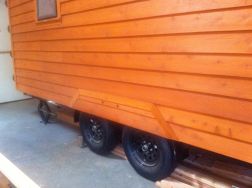
Next I tackled sealing up the gaps around the windows:
Woolly meditations
Just after I finished sealing the windows, I had my unfortunate encounter with the rocks. Once I was vertical again, I decided to start fluffing wool for my insulation. It comes densely packed in boxes. Wool works by trapping warm air between the fibers so for it to be effective it needs to be “fluffed”. While there are machines that can do this, I haven’t heard good reports from those that have tried them. I chose wool because it was natural and nontoxic, and something about having a house made of wood and wool thrills me, but I knew that it would be labor intensive. I’m finding it takes about 10-12 hours to fluff one box of wool thoroughly, and I have six boxes to do. Many tiny housers have wool fluffing parties to get through it faster. I may seek help at some point, but for right now, I’m finding it very meditative doing it on my own. It’s a test of perseverance.

While I’m periodically daunted by how slowly it goes, I’m finding I enjoy the work. I start off with my head buzzing with activity but, as I get into it, the motions get repetitive and rhythmic and my brain slows down and goes into a kind of trance. It’s satisfying to watch the fluffed wool pile up and the compressed wool dwindle. My mother knits, spins, and weaves and I feel akin to those tactile textile traditions. It makes me a little sad that most of us have grown so impatient that we’ve lost the peacefulness of the slow rhythm of working with natural materials and our hands. I know this is a luxury of time that not everyone has, but, for the most part, we seem determined to be a culture of not only “bigger is better”, but “faster is better”. Sometimes in this race to succeed, to get there the quickest way possible, we lose sight of the simple things that can make us happy.
A small, happy life
In The Small, Happy Life, an op-ed piece in the New York Times, David Brooks tells how he asked readers to describe how they view their purpose in life. To his surprise, many of them found their purpose by focusing on the small things. One man kept an old, dinged tin pot to remind himself that not everyone has to shine, which freed him to pursue his interests regardless of how they were valued by society. An 85-year old man discussed that while at his age, the meaning of life is becoming very urgent, his purpose is now concentrated on tending his garden.
I believe that one of the keys to happiness is having a sense of satisfaction. One of the definitions of satisfy is to “give full contentment to”. Satisfaction comes from meeting your desires and needs. It comes from helping others. It comes from making a difference or creating something. It comes from nourishing ourselves and others.
I am as new to gardening as I am to house building, and I don’t think it is a coincidence that I’m drawn to both at this time in my life. While I hope to have many years ahead of me, turning 50 does make you think about life and death and growth. It’s fascinating to me to observe the potential – the drive to become – inherent in every seed and plant. There is something similar and equally ephemeral in inanimate objects as well: the wind and water shaping the rock, the piece of wood holding up a rafter, the wire waiting to carry the current, the empty bucket waiting to be filled. So, too, our bodies want to heal.
Brooks wrote the following about a woman who said: “ ‘Everywhere there are tiny, seemingly inconsequential circumstances that, if explored, provide meaning’ and chances to be generous and kind. Spiritual and emotional growth happens in microscopic increments.”
There seems to be a recurring theme here of change happening incrementally. It is echoed in the electrical and physiological definitions of potential, in how the electrons move down the circuit to turn on a light, or the tiny electrical impulses that causes the muscle to twitch and lift a hammer, one of the many small steps that eventually, inevitably, builds an entire house.
So if you’re feeling overwhelmed or impatient, perhaps you should pause and explore those “tiny, seemingly inconsequential circumstances”. Be curious, as Dee Williams likes to say. Be kind to others and to yourself. Try not to give yourself unreasonable deadlines; everything has an innate, proper time to unfurl naturally. Try to accomplish something, make some progress, every day – and do it well. Be patient. Persevere. Nourish your potent potential. And be sure to appreciate what you’ve accomplished.
A few last thoughts
So to wrap up, I continue to struggle with my impatience (and I still can’t wait to get my walls up!), but I am learning to slow down, tapping into my potential and the potential of all beings and things, finding silver linings in setbacks, taking time to be still in order to heal and revive the creative juices and passions, staying in the moment, appreciating the small things, the tiny movements, and the temporally transient because, really, what else can you do?
…the calligraphy over the altar, the one that is simply titled “Mindfulness,” is actually the Japanese representation of appamada. The kanji is composed of two simpler characters, and the Japanese word for it is nen. The top character means “now, today, this present era, this moment”. It looks like a peaked roof, or a mountain. The bottom character, shin, is usually translated as “heart” or “mind.” A more complete meaning of this character is “heart, mind, intelligence, soul.” So this whole kanji actually represents bringing your whole heart, mind, intelligence, and soul into this very moment, into right now, and into this modern era. Being in present moment awareness is a protection (a roof) or a stable foundation (a mountain) for our heart, mind, intelligence, and soul. In turn, this liberates us to be a benefit in the world, through our energetic, mindful, care. This has so much more depth than the simple term “mindfulness.”
I liked this so much that I am designing my front door to include this symbol as a reminder each time I enter and leave my home. As I was gathering images for this post, I discovered a wonderful continuity shared by the appamada kanji and some of my favorite photos, so I put them together as a sort of personal totem pole or scroll to mark the end of this very long post! (Photo captions and credits are below.)
Be well and may you find your own warm gentle…
Real wood has the kindness
to relieve in the heart,
transmitted through the hand.
Peace in mind for us, also giving.
No matter how things may be difficult to get,
those resembling the real thing:
That is the texture of the tree;
there is the warm gentle.
.
_____________________
-
Image 1: Burrowing owl. A good friend posted this on my FB page. It had the caption: “I’ve got me fluffy knickers on, I do!” Besides making me laugh, I love its determined look. Photo credit: KJ Thurgood
-
Image 2: Looking out of my loft. Photo credit: Naj Haus
-
Image 3: Kanji calligraphy by Nonin Chowaney from the Appamada blog post by Peg Syverson.
-
Image 4: View of Mt. Hood from my uncle and aunt’s property in Oregon. Photo credit: Naj Haus
-
Image 5: Ancient Sequoia tree in the Sierra Mountains, CA. Incidentally, this same tree provided the background texture to my blog site. Photo credit: Naj Haus.




















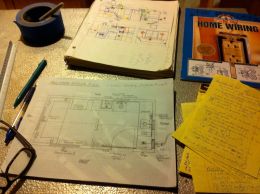


















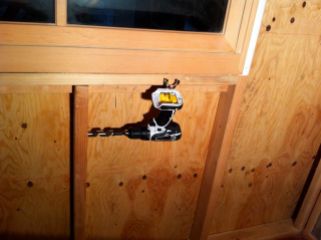






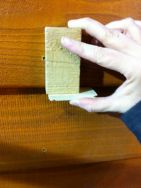










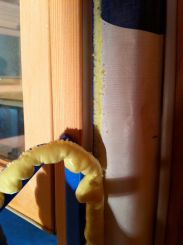
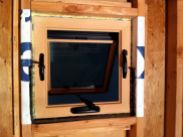








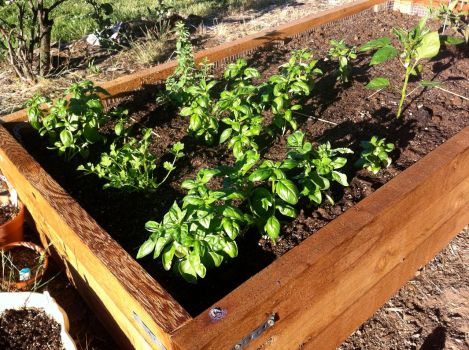




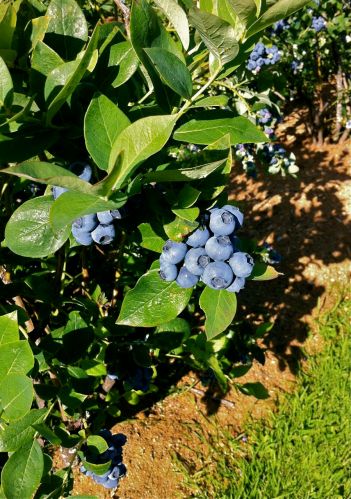






Was thinking of you just the other day and wondering how you were and how your beautiful little house is coming along! And here you are…a ‘little’ beat-up and just as wondrous! Onward! Glad you’re back.
Thanks, Kath – very nice to hear!
Thanks for sharing all your experiences. Where did you get the wool insulation from?
Hi Bob – it’s from Oregon Shepherd.
Thank you for the info
I think it is rare to find blogs that have such organized and sincere poetic expression. Thank you. What a pleasure to read this morning. I’m happy to have found this little spot on the web, and I appreciate you taking the time to share your experiences and thoughts with others (like me!) to see.
Very kind words indeed, Dominique; thank you for taking the time to pass them on! I’m happy to hear the blog resonates with you. While I try to pass on building tips and lessons, what really interests me about this endeavor is what I’m learning about myself, the world, and our place in it. I think we can all use a reminder to keep an eye out for the magic and poetry that happens in the interstices when we slow down a little. It may be a little while before I get the next post up but it will happen when it happens!
Hi Kate I to really enjoy the whole experience of your blog. I was to build a gypsy caravan to travel in…so all your information is helpful. The poetry and life insights are a great bonus. Bob V
Thanks, Bob! I hope your caravan becomes everything you want it to be.
In my ever-expanding quest and unquenchable thirst for tiny house stories, I discovered you, Kate, and I’m thrilled that I did! I share not only tiny house love, but sustainable and slow living, poetry (haikus or freeform for me), growing food, aging, and passion for simple, artfully crafted wood furniture.
I will delve into your archives for now but do very much hope to read some new posts of your tiny journey soon.
Peace……..
Thanks, Hazel! Sorry for the long delay in approving your post – I am only now getting back to blogging (sporadically!)
Thank you Kate, your posts are like a soothing waterfall of soul and patience and healing. I feel very connected to this one and so glad I just found your blog again. I’m in my marathon of patience with healing my back and my foot, and your words inspire me and help me feel connected to you and all of us finding our healing and winding path in this beautiful world. Much love to you and your big healing and tiny house and to the trees! I just love the google translator poetry!
Marilyn Latta
Hi Marilyn – so good to hear from you! I’m glad you connected with the post (though sorry to hear you’re still dealing with your injuries). Finding patience with healing, especially when you’re so used to being active, is definitely a challenge. Sending you lots of good healing juju. Be well!